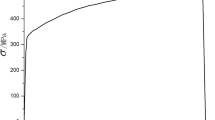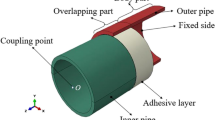Abstract
Laboratory tests were conducted to understand and describe how the reinforcement layers of a carbon fiber epoxy composite material can enable a steel line pipe specimen with a metal loss defect to withstand pressure loading, and to compare the test results with those predicted by mechanics of materials and by finite element numerical solutions developed previously. Hydrostatic burst tests were performed on three pipe (API 5L X65 ERW) specimens: one with metal loss defect, one without metal loss defect, and one with metal loss defect but repaired with a carbon-fiber-reinforced epoxy composite system. Fiber Bragg grating strain gages were used during the tests of the repaired specimen. The strain gages were bonded either directly on the surface of the defect, or were inserted in between some of the composite layers in order to show the reinforcement’s effective contribution to the strength of the repaired pipes. The analytical and numerical results agreed very satisfactorily with experimentally determined burst pressures and pressure–strain curves, showing that the behavior of composite reinforced pipelines can be well predicted by using simple mechanics of materials or sophisticated finite element solutions.
Similar content being viewed by others
References
Duel, J., Wilson, J., and Kessler, M., “Analysis of a Carbon Composite Overwrap Pipeline Repair System,” International Journal of Pressure Vessels and Piping 85:782–788 (2008).
Rosas, M.A.P., Evaluation of Sleeve Type Repair Models for Pipelines with Thickness Loss Defects, Doctoral Thesis (in Portuguese), Mechanical Engineering Department, Pontifical Catholic University of Rio de Janeiro, PUC-Rio, September (2010).
API Specification 5L, Specification for Line Pipe, 44th Edition, American Petroleum Institute, Washington, DC (2009).
ASME, ASME-B31G Manual for Determining the Remaining Strength of Corroded Pipelines - A Supplement to ANSI/ASME B31 Code for Pressure Piping, The American Society of Mechanical Engineers, New York (2009).
DNV, Corroded Pipelines, Recommended Practice RP-F101, Det Norske Veritas, Høvik, Norway (1999).
Freire, J.L.F., Vieira, R.D., Castro, J.T.P, and Benjamin, A.C., “Burst Tests of Pipeline with Extensive Longitudinal Metal Loss,” Experimental Techniques, 30(6):60–65 (2006).
Freire, J.L.F., Vieira, R.D., and Diniz, J.C., “Effectiveness of Composite Repairs Applied to Damaged Pipeline,” Experimental Techniques 31(5):59–66 (2007).
Author information
Authors and Affiliations
Corresponding author
Rights and permissions
About this article
Cite this article
Freire, J.L.F., Perrut, V.A., Braga, A.M.B. et al. Use of FBG strain gages on a pipeline specimen repaired with a CFRE composite. Exp Tech 39, 70–79 (2015). https://doi.org/10.1111/j.1747-1567.2012.00866.x
Received:
Accepted:
Published:
Issue Date:
DOI: https://doi.org/10.1111/j.1747-1567.2012.00866.x




